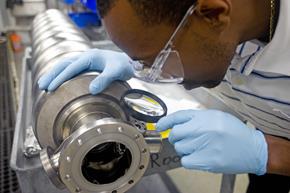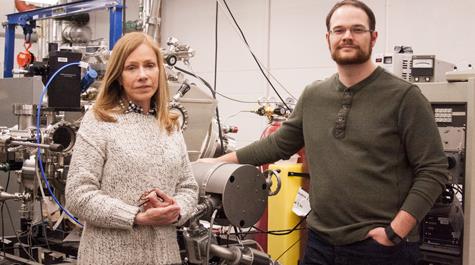A grad student works toward the next generation of particle accelerator
It takes a large instrument to investigate a small particle. Particle accelerators, used by physicists to study the elementary particles from which all matter is constructed, are usually built underground and their size is often measured in miles.
One such racetrack stretches for slightly less than a mile under Newport News, Virginia, at the U.S. Department of Energy’s Thomas Jefferson National Accelerator Facility, commonly called Jefferson Lab, or just JLab. As knowledge of fundamental particles advances through new discoveries, scientists need better particle accelerators. Matthew Burton, a graduate student in the William & Mary Department of Physics, is part of the effort to make a better accelerator.
“I do love physics,” Burton said. “I wanted hands-on work, and with a project in this field with superconductivity, there is a lot of room to grow.”
Burton is concentrating on an accelerator component called a radio-frequency (RF) cavity. The DOE awarded Burton a highly competitive Science Graduate Student Research award to support his thesis project, titled “Development and Characterization of Superconducting Thin Films for SRF Accelerator Cavities.”
The RF cavities are donut-shaped superconductors that accelerate particles so that they can collide with targets or other particles in an effort to break them down into their smaller components. The superconducting RF (SRF) cavities currently used, Burton explained, are made of bulk niobium, a metal that must be cooled to -257 degrees Celsius to behave as a superconductor. The accelerator at JLab uses 338 linked niobium cavities, most of which extend down the two sides of the Jefferson Lab’s accelerator, similar to the straight sides of a track field.
 Burton explained that cavities made of niobium present some problems. For one thing, niobium is a highly expensive metal and it also has technical drawbacks related to its ability to conduct heat. In addition, bulk niobium SRF cavities have progressed to a point where scientists will require a new kind of cavity that offers performance beyond what bulk niobium can provide.
Burton explained that cavities made of niobium present some problems. For one thing, niobium is a highly expensive metal and it also has technical drawbacks related to its ability to conduct heat. In addition, bulk niobium SRF cavities have progressed to a point where scientists will require a new kind of cavity that offers performance beyond what bulk niobium can provide.
To combat these issues, Burton’s project has two facets: one is to test the possibility of using niobium-based thin films to coat cavities made of copper, which is cheaper and a more efficient heat conductor. The other deals with using multilayer thin films to create an even better cavity using other suitable materials.
Ale Lukaszew is the Virginia Microelectronics Consortium Distinguished Professor of Physics at William & Mary and is Burton’s mentor and research advisor. Lukaszew explained the importance of improving accelerators to try to keep up the technical requirements of advancing experiments.
“Had they had at CERN the quality cavity that we can make today, the Higgs—the famous Higgs boson that was such a big deal a while ago— would have been discovered 25 years ago.” Lukaszew said. The cavities that CERN was using to conduct experiments at the time reached an energy level just below what was necessary to prove the existence of the Higgs boson, she explained.
The process of lining cavities with thin films offers several challenges. Lukaszew explained that the film must have uniform thickness throughout the cavity and the film must also have the proper surface qualities. The slightest imperfection can quench the cavity, i.e. disrupt its superconducting character, superheating and dumping all the extra heat to the environment.
“Let’s say you do get the right thickness,” said Lukaszew, “you get the right surface for the most part, but in some place you have a spike, like a little dust speck similar to when you are painting your home. That is going to be a problem because that’s exactly where things fail, since the spike can provide magnetic field pinning sites that can disrupt the superconducting character of the material leading to a cavity quench.”
Burton explained that the technique of lining cavities with thin films has been tested, but mainly with coupon samples, postage stamp-sized pieces of film. Coupon samples can give an idea of how the cavity would behave if the entire inside was coated with a thin film. Burton will be among the first to attempt cavities fully lined with a niobium thin film, instead of simply using coupon samples, using a new process suitable to improved films.
Burton is working with a process called HiPIMS or High Impulse Magnetron Sputtering to apply denser thin films— more “bulk-like,” he says— evenly throughout the cavity.
“This hasn’t been used before.” said Burton “CERN used DC magnetron sputtering, which is an older method, for their original accelerator, which did go well but it didn’t work as well as the bulk niobium cavities, since such films were porous. Our goal is to use this new technique to try to get better control over the density of the films.”
Burton and other scientists trying to produce a workable niobium thin film cavity are racing against the clock. Lukaszew explained that CERN has already started upgrading their particle accelerators.
“They need an answer within four years if what we are doing is better than the bulk-like cavities because then they will be implemented at CERN instead.” Lukaszew said.
The second phase of Burton’s work, using thin films to improve the performance of bulk niobium cavities, draws on an idea by an Old Dominion University theorist, Alexander Gurevich, who proposed a model using multilayer thin films to increase the accelerating field of bulk niobium cavities.
Currently, the bulk niobium cavities can only withstand so much power before they quench, or fail. To combat this problem, Gurevich proposed that the inner surface of the cavities could be coated with multilayer thin films incorporating superconducting layers, alternating with insulating layers to increase the optimal accelerating field of the cavities.
“If you make each layer thin enough it will have a higher critical field than the bulk value does,” Burton said. “This is one area where the thin film can do better than the bulk material.”
The more power input into the cavities, the faster the particles will accelerate. Burton explained that the alternating thin film and insulating layers allow the cavities to withstand higher accelerating fields.
“His theory predicts that you could theoretically get twice the maximum accelerating field out of these cavities than you can now,” Burton said. “Hence, you could make an accelerator half of its present size.”
Improved accelerator cavities have immediate implications outside of the world of particle physics. Lukaszew has received substantial funding from the Defense Threat Reduction Agency (DTRA), an agency of the U.S. Department of Defense, to develop technology that would allow for the construction of smaller particle accelerators. Burton explained that the smaller particle accelerators could be installed at ports and similar strategic locations to check incoming cargo for the presence of fissile nuclear material.
Burton said that the more efficient multilayered cavities would make possible a particle accelerator small enough to be put into use at a port for this particular application.
“If you could get an enhanced cavity where you could get twice the accelerating field from them, you could make an accelerator that would fit at a shipping port. You could even fit one in the back of a semi-truck,” he said. He added that this second aspect of his niobium project will take him into uncharted territory.
“People have deposited on copper before, but nobody has done the multilayer approach, so this will be the first test of the Gurevich model on real cavities,” Burton said. Skip to main content
Skip to main content

